Impact of Therapeutic Alliance on Dissociative Disorder Treatment
VerifiedAdded on 2023/04/25
|33
|6633
|114
Report
AI Summary
This report, a case study from RVI Hospitals, England, investigates the impact of the therapeutic alliance on treatment outcomes for patients with dissociative disorders. The study includes an introduction outlining the research questions, rationale, and a comprehensive literature review exploring the understanding of dissociative disorders and therapeutic relationships. It delves into the difficulties therapists face in diagnosing dissociative symptoms and examines various factors influencing prognosis. The methodology section discusses the research methods used, followed by findings presented through graphs and tables. The conclusion synthesizes the research, and the report evaluates the potential relevance for practice and includes a reflection section, references, and appendices containing a survey questionnaire and observation records. The research aims to contribute to better understanding of the alliance between therapists and patients with dissociative disorders and how it can improve treatment outcomes. The report also explores factors impacting diagnosis, such as lack of training and patient behaviors, and suggests ways to improve outcomes through therapeutic interventions and patient engagement.
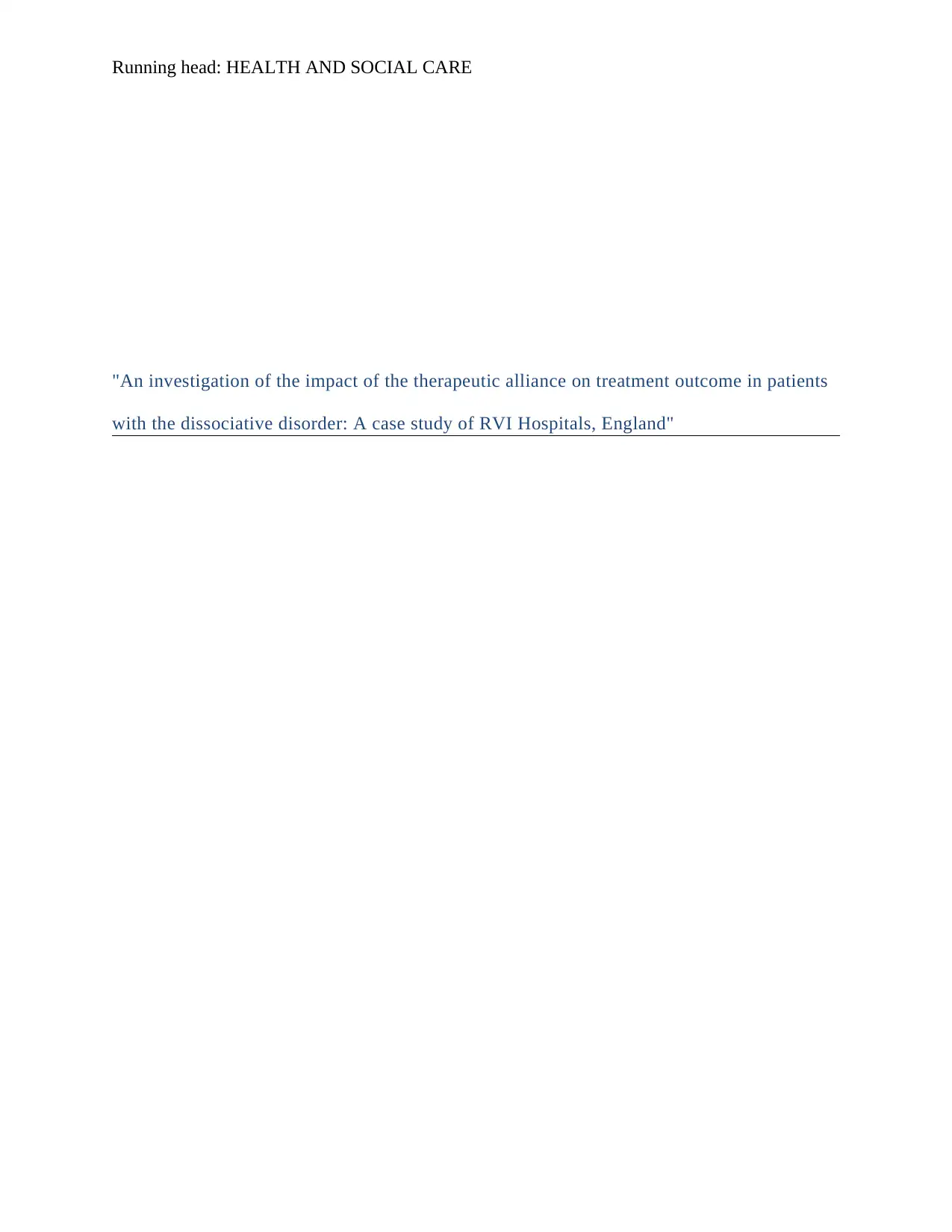
Running head: HEALTH AND SOCIAL CARE
"An investigation of the impact of the therapeutic alliance on treatment outcome in patients
with the dissociative disorder: A case study of RVI Hospitals, England"
"An investigation of the impact of the therapeutic alliance on treatment outcome in patients
with the dissociative disorder: A case study of RVI Hospitals, England"
Paraphrase This Document
Need a fresh take? Get an instant paraphrase of this document with our AI Paraphraser
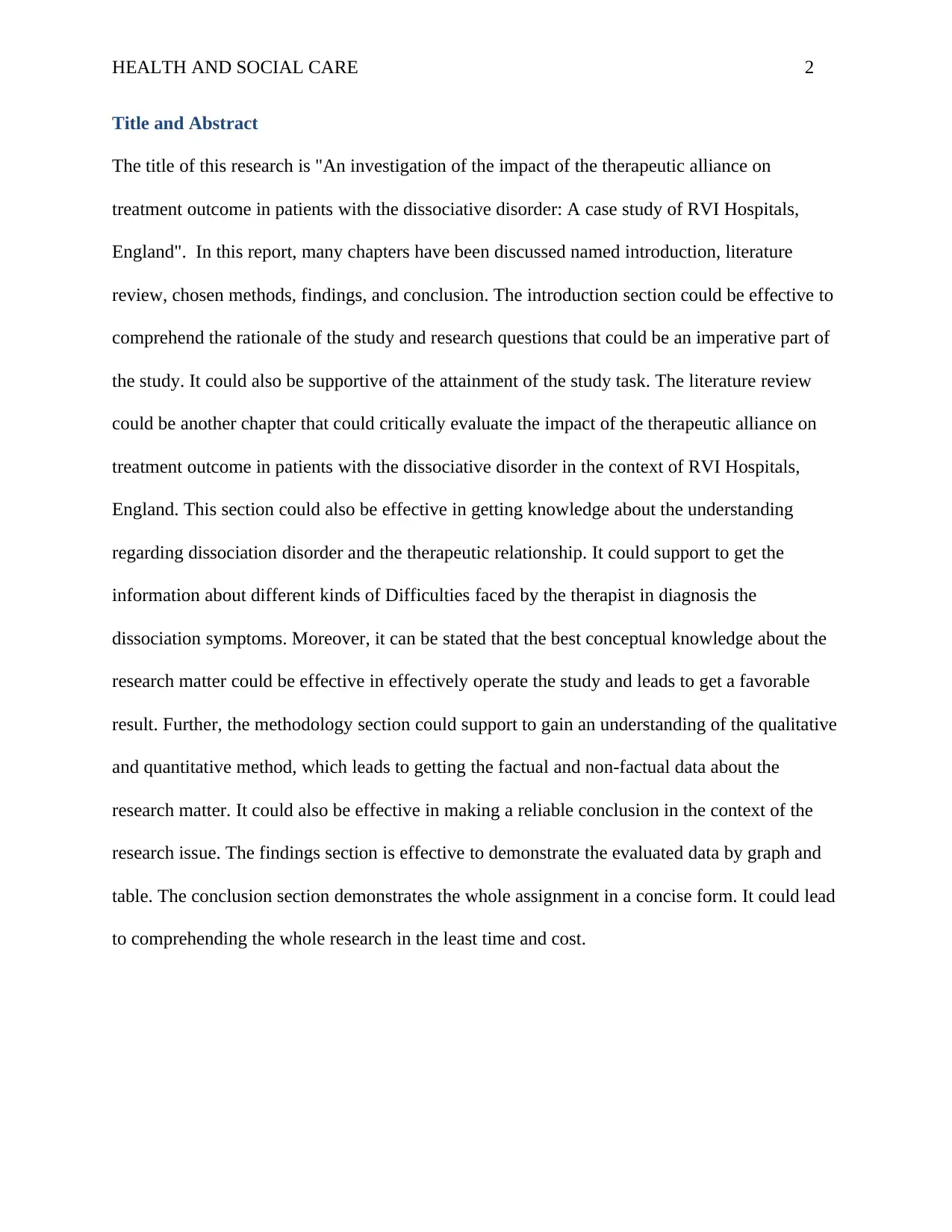
HEALTH AND SOCIAL CARE 2
Title and Abstract
The title of this research is "An investigation of the impact of the therapeutic alliance on
treatment outcome in patients with the dissociative disorder: A case study of RVI Hospitals,
England". In this report, many chapters have been discussed named introduction, literature
review, chosen methods, findings, and conclusion. The introduction section could be effective to
comprehend the rationale of the study and research questions that could be an imperative part of
the study. It could also be supportive of the attainment of the study task. The literature review
could be another chapter that could critically evaluate the impact of the therapeutic alliance on
treatment outcome in patients with the dissociative disorder in the context of RVI Hospitals,
England. This section could also be effective in getting knowledge about the understanding
regarding dissociation disorder and the therapeutic relationship. It could support to get the
information about different kinds of Difficulties faced by the therapist in diagnosis the
dissociation symptoms. Moreover, it can be stated that the best conceptual knowledge about the
research matter could be effective in effectively operate the study and leads to get a favorable
result. Further, the methodology section could support to gain an understanding of the qualitative
and quantitative method, which leads to getting the factual and non-factual data about the
research matter. It could also be effective in making a reliable conclusion in the context of the
research issue. The findings section is effective to demonstrate the evaluated data by graph and
table. The conclusion section demonstrates the whole assignment in a concise form. It could lead
to comprehending the whole research in the least time and cost.
Title and Abstract
The title of this research is "An investigation of the impact of the therapeutic alliance on
treatment outcome in patients with the dissociative disorder: A case study of RVI Hospitals,
England". In this report, many chapters have been discussed named introduction, literature
review, chosen methods, findings, and conclusion. The introduction section could be effective to
comprehend the rationale of the study and research questions that could be an imperative part of
the study. It could also be supportive of the attainment of the study task. The literature review
could be another chapter that could critically evaluate the impact of the therapeutic alliance on
treatment outcome in patients with the dissociative disorder in the context of RVI Hospitals,
England. This section could also be effective in getting knowledge about the understanding
regarding dissociation disorder and the therapeutic relationship. It could support to get the
information about different kinds of Difficulties faced by the therapist in diagnosis the
dissociation symptoms. Moreover, it can be stated that the best conceptual knowledge about the
research matter could be effective in effectively operate the study and leads to get a favorable
result. Further, the methodology section could support to gain an understanding of the qualitative
and quantitative method, which leads to getting the factual and non-factual data about the
research matter. It could also be effective in making a reliable conclusion in the context of the
research issue. The findings section is effective to demonstrate the evaluated data by graph and
table. The conclusion section demonstrates the whole assignment in a concise form. It could lead
to comprehending the whole research in the least time and cost.
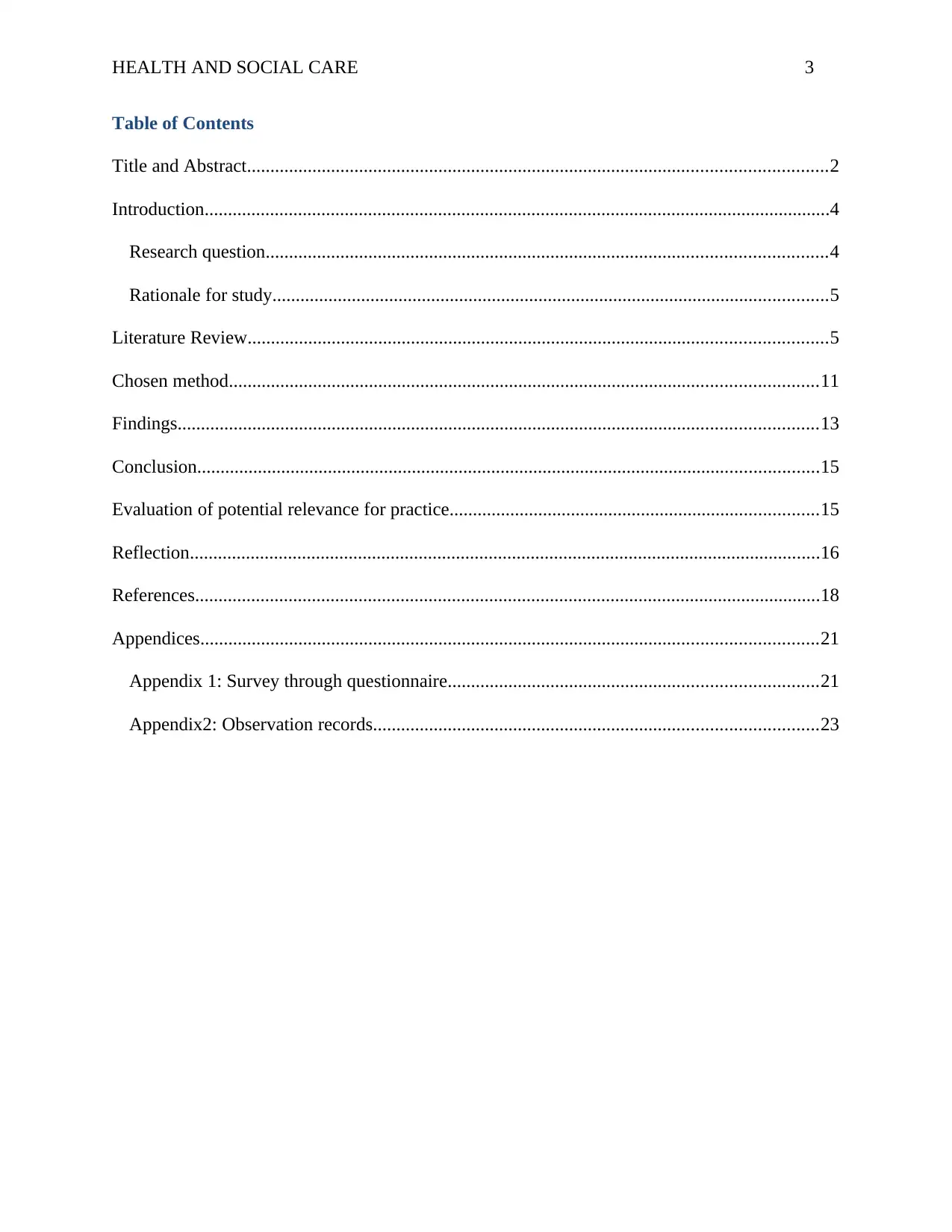
HEALTH AND SOCIAL CARE 3
Table of Contents
Title and Abstract............................................................................................................................2
Introduction......................................................................................................................................4
Research question........................................................................................................................4
Rationale for study.......................................................................................................................5
Literature Review............................................................................................................................5
Chosen method..............................................................................................................................11
Findings.........................................................................................................................................13
Conclusion.....................................................................................................................................15
Evaluation of potential relevance for practice...............................................................................15
Reflection.......................................................................................................................................16
References......................................................................................................................................18
Appendices....................................................................................................................................21
Appendix 1: Survey through questionnaire...............................................................................21
Appendix2: Observation records...............................................................................................23
Table of Contents
Title and Abstract............................................................................................................................2
Introduction......................................................................................................................................4
Research question........................................................................................................................4
Rationale for study.......................................................................................................................5
Literature Review............................................................................................................................5
Chosen method..............................................................................................................................11
Findings.........................................................................................................................................13
Conclusion.....................................................................................................................................15
Evaluation of potential relevance for practice...............................................................................15
Reflection.......................................................................................................................................16
References......................................................................................................................................18
Appendices....................................................................................................................................21
Appendix 1: Survey through questionnaire...............................................................................21
Appendix2: Observation records...............................................................................................23
⊘ This is a preview!⊘
Do you want full access?
Subscribe today to unlock all pages.

Trusted by 1+ million students worldwide
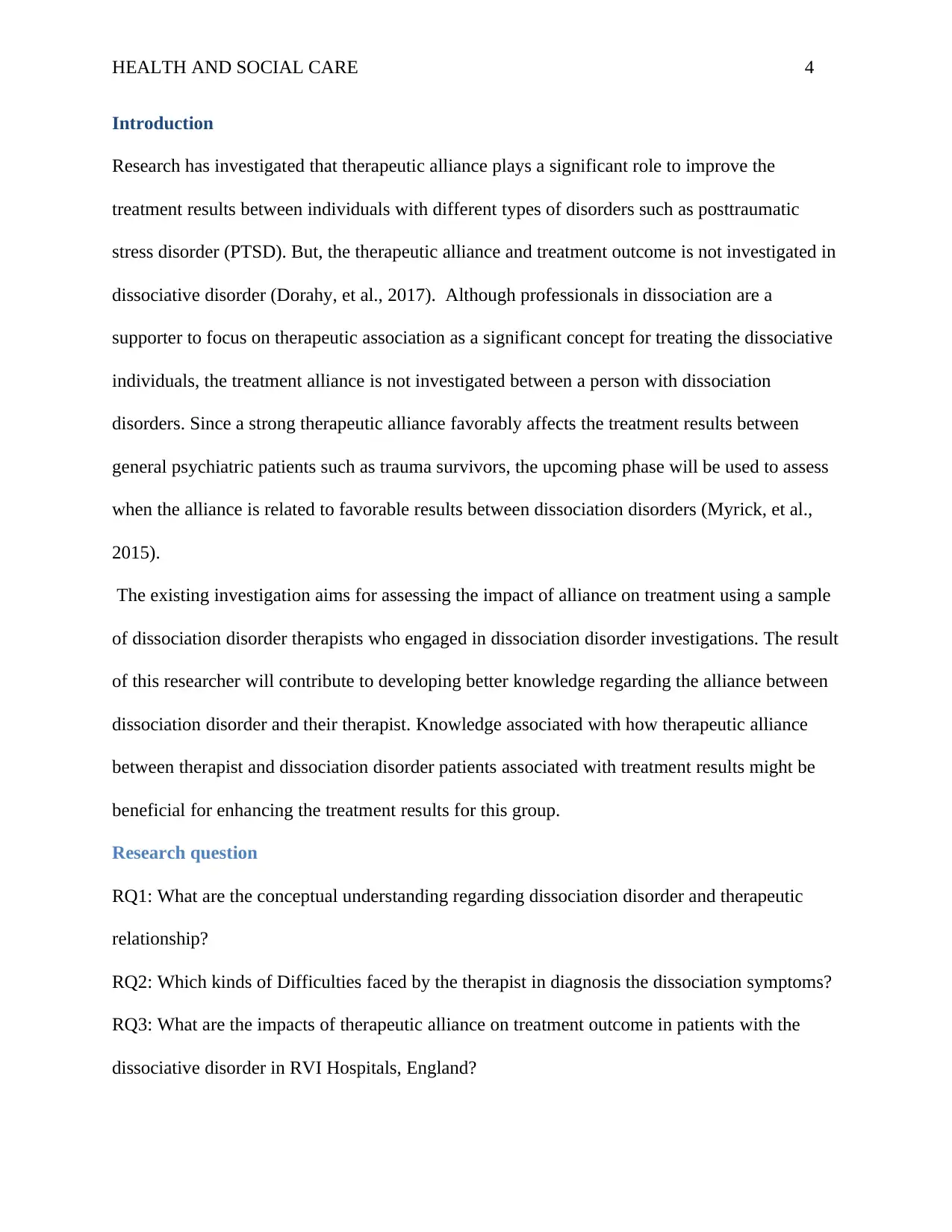
HEALTH AND SOCIAL CARE 4
Introduction
Research has investigated that therapeutic alliance plays a significant role to improve the
treatment results between individuals with different types of disorders such as posttraumatic
stress disorder (PTSD). But, the therapeutic alliance and treatment outcome is not investigated in
dissociative disorder (Dorahy, et al., 2017). Although professionals in dissociation are a
supporter to focus on therapeutic association as a significant concept for treating the dissociative
individuals, the treatment alliance is not investigated between a person with dissociation
disorders. Since a strong therapeutic alliance favorably affects the treatment results between
general psychiatric patients such as trauma survivors, the upcoming phase will be used to assess
when the alliance is related to favorable results between dissociation disorders (Myrick, et al.,
2015).
The existing investigation aims for assessing the impact of alliance on treatment using a sample
of dissociation disorder therapists who engaged in dissociation disorder investigations. The result
of this researcher will contribute to developing better knowledge regarding the alliance between
dissociation disorder and their therapist. Knowledge associated with how therapeutic alliance
between therapist and dissociation disorder patients associated with treatment results might be
beneficial for enhancing the treatment results for this group.
Research question
RQ1: What are the conceptual understanding regarding dissociation disorder and therapeutic
relationship?
RQ2: Which kinds of Difficulties faced by the therapist in diagnosis the dissociation symptoms?
RQ3: What are the impacts of therapeutic alliance on treatment outcome in patients with the
dissociative disorder in RVI Hospitals, England?
Introduction
Research has investigated that therapeutic alliance plays a significant role to improve the
treatment results between individuals with different types of disorders such as posttraumatic
stress disorder (PTSD). But, the therapeutic alliance and treatment outcome is not investigated in
dissociative disorder (Dorahy, et al., 2017). Although professionals in dissociation are a
supporter to focus on therapeutic association as a significant concept for treating the dissociative
individuals, the treatment alliance is not investigated between a person with dissociation
disorders. Since a strong therapeutic alliance favorably affects the treatment results between
general psychiatric patients such as trauma survivors, the upcoming phase will be used to assess
when the alliance is related to favorable results between dissociation disorders (Myrick, et al.,
2015).
The existing investigation aims for assessing the impact of alliance on treatment using a sample
of dissociation disorder therapists who engaged in dissociation disorder investigations. The result
of this researcher will contribute to developing better knowledge regarding the alliance between
dissociation disorder and their therapist. Knowledge associated with how therapeutic alliance
between therapist and dissociation disorder patients associated with treatment results might be
beneficial for enhancing the treatment results for this group.
Research question
RQ1: What are the conceptual understanding regarding dissociation disorder and therapeutic
relationship?
RQ2: Which kinds of Difficulties faced by the therapist in diagnosis the dissociation symptoms?
RQ3: What are the impacts of therapeutic alliance on treatment outcome in patients with the
dissociative disorder in RVI Hospitals, England?
Paraphrase This Document
Need a fresh take? Get an instant paraphrase of this document with our AI Paraphraser
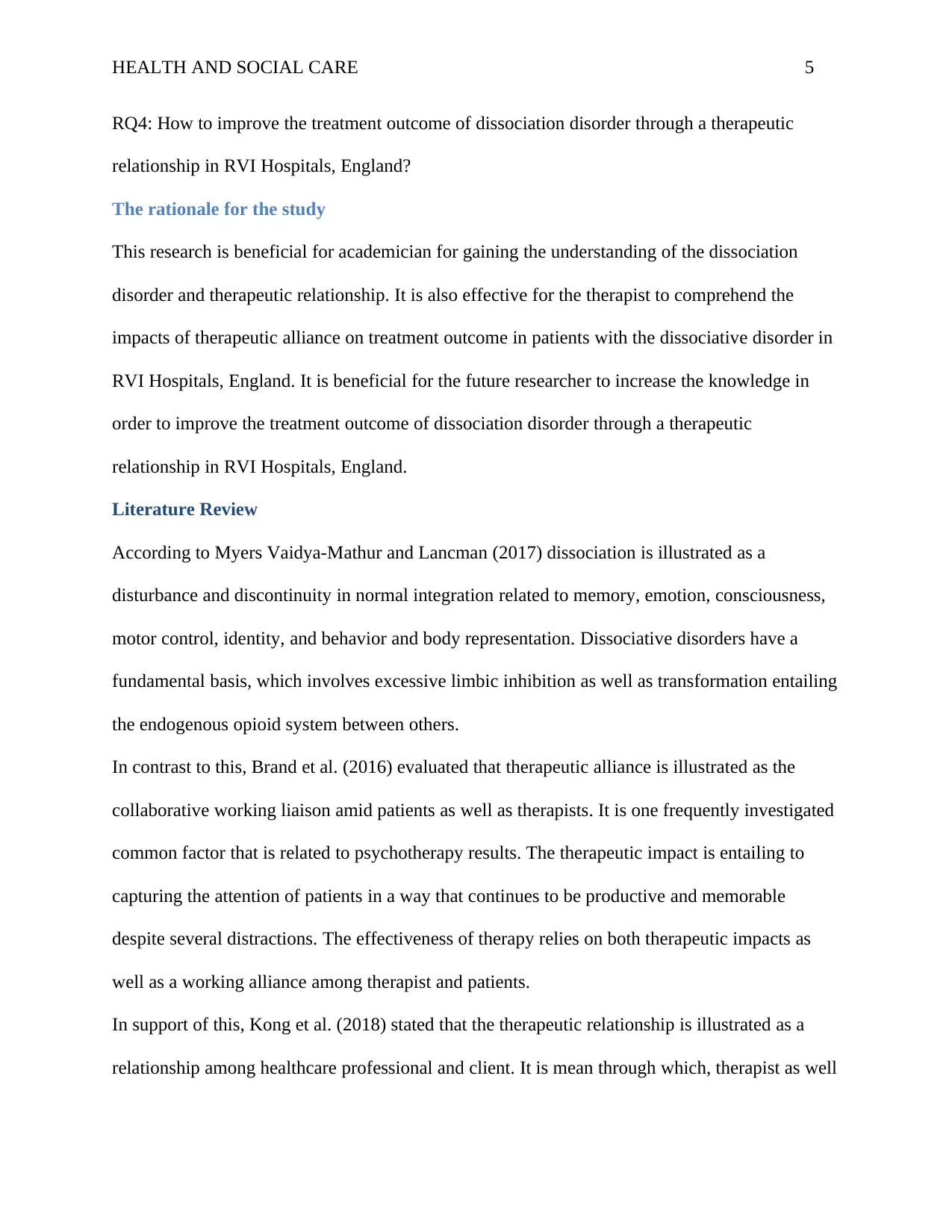
HEALTH AND SOCIAL CARE 5
RQ4: How to improve the treatment outcome of dissociation disorder through a therapeutic
relationship in RVI Hospitals, England?
The rationale for the study
This research is beneficial for academician for gaining the understanding of the dissociation
disorder and therapeutic relationship. It is also effective for the therapist to comprehend the
impacts of therapeutic alliance on treatment outcome in patients with the dissociative disorder in
RVI Hospitals, England. It is beneficial for the future researcher to increase the knowledge in
order to improve the treatment outcome of dissociation disorder through a therapeutic
relationship in RVI Hospitals, England.
Literature Review
According to Myers Vaidya-Mathur and Lancman (2017) dissociation is illustrated as a
disturbance and discontinuity in normal integration related to memory, emotion, consciousness,
motor control, identity, and behavior and body representation. Dissociative disorders have a
fundamental basis, which involves excessive limbic inhibition as well as transformation entailing
the endogenous opioid system between others.
In contrast to this, Brand et al. (2016) evaluated that therapeutic alliance is illustrated as the
collaborative working liaison amid patients as well as therapists. It is one frequently investigated
common factor that is related to psychotherapy results. The therapeutic impact is entailing to
capturing the attention of patients in a way that continues to be productive and memorable
despite several distractions. The effectiveness of therapy relies on both therapeutic impacts as
well as a working alliance among therapist and patients.
In support of this, Kong et al. (2018) stated that the therapeutic relationship is illustrated as a
relationship among healthcare professional and client. It is mean through which, therapist as well
RQ4: How to improve the treatment outcome of dissociation disorder through a therapeutic
relationship in RVI Hospitals, England?
The rationale for the study
This research is beneficial for academician for gaining the understanding of the dissociation
disorder and therapeutic relationship. It is also effective for the therapist to comprehend the
impacts of therapeutic alliance on treatment outcome in patients with the dissociative disorder in
RVI Hospitals, England. It is beneficial for the future researcher to increase the knowledge in
order to improve the treatment outcome of dissociation disorder through a therapeutic
relationship in RVI Hospitals, England.
Literature Review
According to Myers Vaidya-Mathur and Lancman (2017) dissociation is illustrated as a
disturbance and discontinuity in normal integration related to memory, emotion, consciousness,
motor control, identity, and behavior and body representation. Dissociative disorders have a
fundamental basis, which involves excessive limbic inhibition as well as transformation entailing
the endogenous opioid system between others.
In contrast to this, Brand et al. (2016) evaluated that therapeutic alliance is illustrated as the
collaborative working liaison amid patients as well as therapists. It is one frequently investigated
common factor that is related to psychotherapy results. The therapeutic impact is entailing to
capturing the attention of patients in a way that continues to be productive and memorable
despite several distractions. The effectiveness of therapy relies on both therapeutic impacts as
well as a working alliance among therapist and patients.
In support of this, Kong et al. (2018) stated that the therapeutic relationship is illustrated as a
relationship among healthcare professional and client. It is mean through which, therapist as well
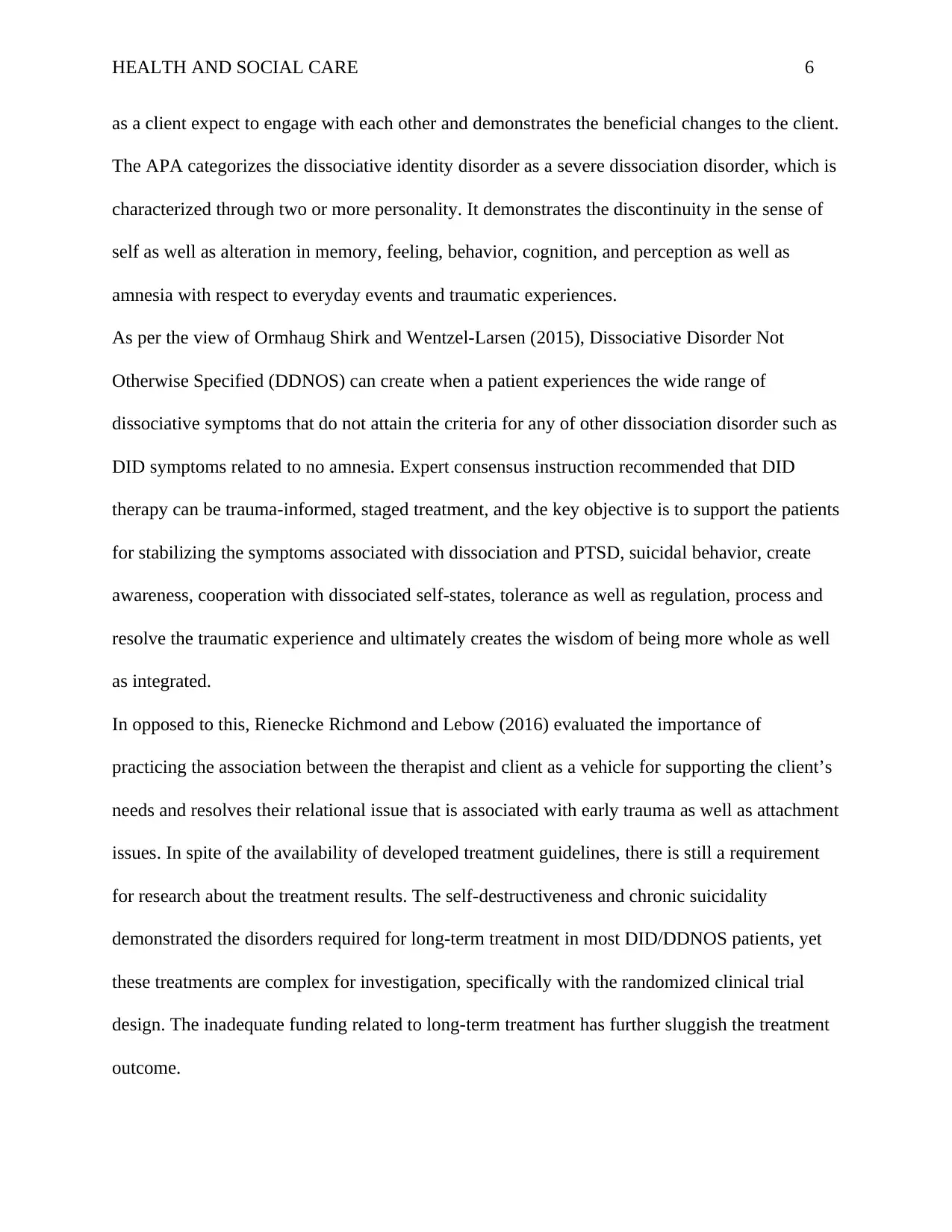
HEALTH AND SOCIAL CARE 6
as a client expect to engage with each other and demonstrates the beneficial changes to the client.
The APA categorizes the dissociative identity disorder as a severe dissociation disorder, which is
characterized through two or more personality. It demonstrates the discontinuity in the sense of
self as well as alteration in memory, feeling, behavior, cognition, and perception as well as
amnesia with respect to everyday events and traumatic experiences.
As per the view of Ormhaug Shirk and Wentzel-Larsen (2015), Dissociative Disorder Not
Otherwise Specified (DDNOS) can create when a patient experiences the wide range of
dissociative symptoms that do not attain the criteria for any of other dissociation disorder such as
DID symptoms related to no amnesia. Expert consensus instruction recommended that DID
therapy can be trauma-informed, staged treatment, and the key objective is to support the patients
for stabilizing the symptoms associated with dissociation and PTSD, suicidal behavior, create
awareness, cooperation with dissociated self-states, tolerance as well as regulation, process and
resolve the traumatic experience and ultimately creates the wisdom of being more whole as well
as integrated.
In opposed to this, Rienecke Richmond and Lebow (2016) evaluated the importance of
practicing the association between the therapist and client as a vehicle for supporting the client’s
needs and resolves their relational issue that is associated with early trauma as well as attachment
issues. In spite of the availability of developed treatment guidelines, there is still a requirement
for research about the treatment results. The self-destructiveness and chronic suicidality
demonstrated the disorders required for long-term treatment in most DID/DDNOS patients, yet
these treatments are complex for investigation, specifically with the randomized clinical trial
design. The inadequate funding related to long-term treatment has further sluggish the treatment
outcome.
as a client expect to engage with each other and demonstrates the beneficial changes to the client.
The APA categorizes the dissociative identity disorder as a severe dissociation disorder, which is
characterized through two or more personality. It demonstrates the discontinuity in the sense of
self as well as alteration in memory, feeling, behavior, cognition, and perception as well as
amnesia with respect to everyday events and traumatic experiences.
As per the view of Ormhaug Shirk and Wentzel-Larsen (2015), Dissociative Disorder Not
Otherwise Specified (DDNOS) can create when a patient experiences the wide range of
dissociative symptoms that do not attain the criteria for any of other dissociation disorder such as
DID symptoms related to no amnesia. Expert consensus instruction recommended that DID
therapy can be trauma-informed, staged treatment, and the key objective is to support the patients
for stabilizing the symptoms associated with dissociation and PTSD, suicidal behavior, create
awareness, cooperation with dissociated self-states, tolerance as well as regulation, process and
resolve the traumatic experience and ultimately creates the wisdom of being more whole as well
as integrated.
In opposed to this, Rienecke Richmond and Lebow (2016) evaluated the importance of
practicing the association between the therapist and client as a vehicle for supporting the client’s
needs and resolves their relational issue that is associated with early trauma as well as attachment
issues. In spite of the availability of developed treatment guidelines, there is still a requirement
for research about the treatment results. The self-destructiveness and chronic suicidality
demonstrated the disorders required for long-term treatment in most DID/DDNOS patients, yet
these treatments are complex for investigation, specifically with the randomized clinical trial
design. The inadequate funding related to long-term treatment has further sluggish the treatment
outcome.
⊘ This is a preview!⊘
Do you want full access?
Subscribe today to unlock all pages.

Trusted by 1+ million students worldwide
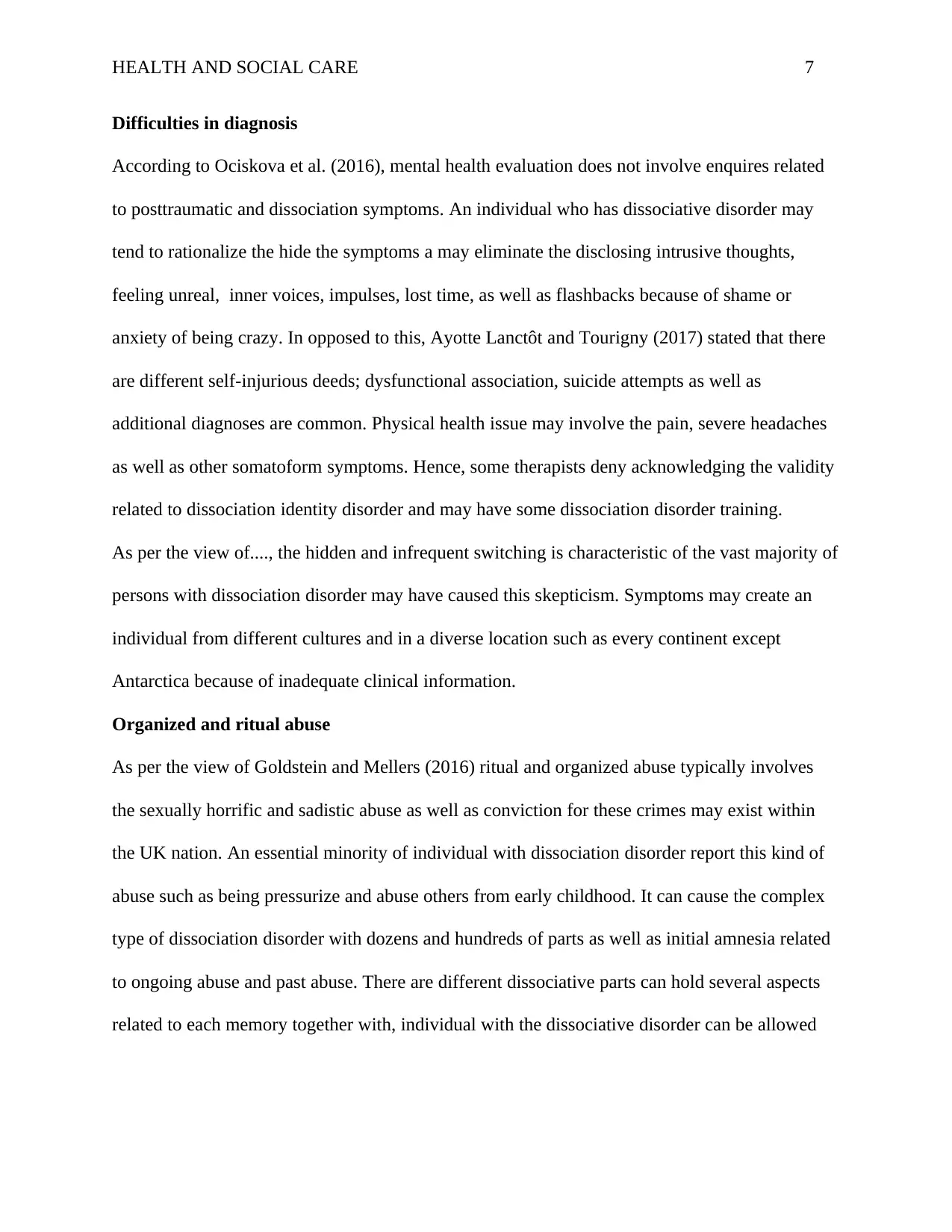
HEALTH AND SOCIAL CARE 7
Difficulties in diagnosis
According to Ociskova et al. (2016), mental health evaluation does not involve enquires related
to posttraumatic and dissociation symptoms. An individual who has dissociative disorder may
tend to rationalize the hide the symptoms a may eliminate the disclosing intrusive thoughts,
feeling unreal, inner voices, impulses, lost time, as well as flashbacks because of shame or
anxiety of being crazy. In opposed to this, Ayotte Lanctôt and Tourigny (2017) stated that there
are different self-injurious deeds; dysfunctional association, suicide attempts as well as
additional diagnoses are common. Physical health issue may involve the pain, severe headaches
as well as other somatoform symptoms. Hence, some therapists deny acknowledging the validity
related to dissociation identity disorder and may have some dissociation disorder training.
As per the view of...., the hidden and infrequent switching is characteristic of the vast majority of
persons with dissociation disorder may have caused this skepticism. Symptoms may create an
individual from different cultures and in a diverse location such as every continent except
Antarctica because of inadequate clinical information.
Organized and ritual abuse
As per the view of Goldstein and Mellers (2016) ritual and organized abuse typically involves
the sexually horrific and sadistic abuse as well as conviction for these crimes may exist within
the UK nation. An essential minority of individual with dissociation disorder report this kind of
abuse such as being pressurize and abuse others from early childhood. It can cause the complex
type of dissociation disorder with dozens and hundreds of parts as well as initial amnesia related
to ongoing abuse and past abuse. There are different dissociative parts can hold several aspects
related to each memory together with, individual with the dissociative disorder can be allowed
Difficulties in diagnosis
According to Ociskova et al. (2016), mental health evaluation does not involve enquires related
to posttraumatic and dissociation symptoms. An individual who has dissociative disorder may
tend to rationalize the hide the symptoms a may eliminate the disclosing intrusive thoughts,
feeling unreal, inner voices, impulses, lost time, as well as flashbacks because of shame or
anxiety of being crazy. In opposed to this, Ayotte Lanctôt and Tourigny (2017) stated that there
are different self-injurious deeds; dysfunctional association, suicide attempts as well as
additional diagnoses are common. Physical health issue may involve the pain, severe headaches
as well as other somatoform symptoms. Hence, some therapists deny acknowledging the validity
related to dissociation identity disorder and may have some dissociation disorder training.
As per the view of...., the hidden and infrequent switching is characteristic of the vast majority of
persons with dissociation disorder may have caused this skepticism. Symptoms may create an
individual from different cultures and in a diverse location such as every continent except
Antarctica because of inadequate clinical information.
Organized and ritual abuse
As per the view of Goldstein and Mellers (2016) ritual and organized abuse typically involves
the sexually horrific and sadistic abuse as well as conviction for these crimes may exist within
the UK nation. An essential minority of individual with dissociation disorder report this kind of
abuse such as being pressurize and abuse others from early childhood. It can cause the complex
type of dissociation disorder with dozens and hundreds of parts as well as initial amnesia related
to ongoing abuse and past abuse. There are different dissociative parts can hold several aspects
related to each memory together with, individual with the dissociative disorder can be allowed
Paraphrase This Document
Need a fresh take? Get an instant paraphrase of this document with our AI Paraphraser
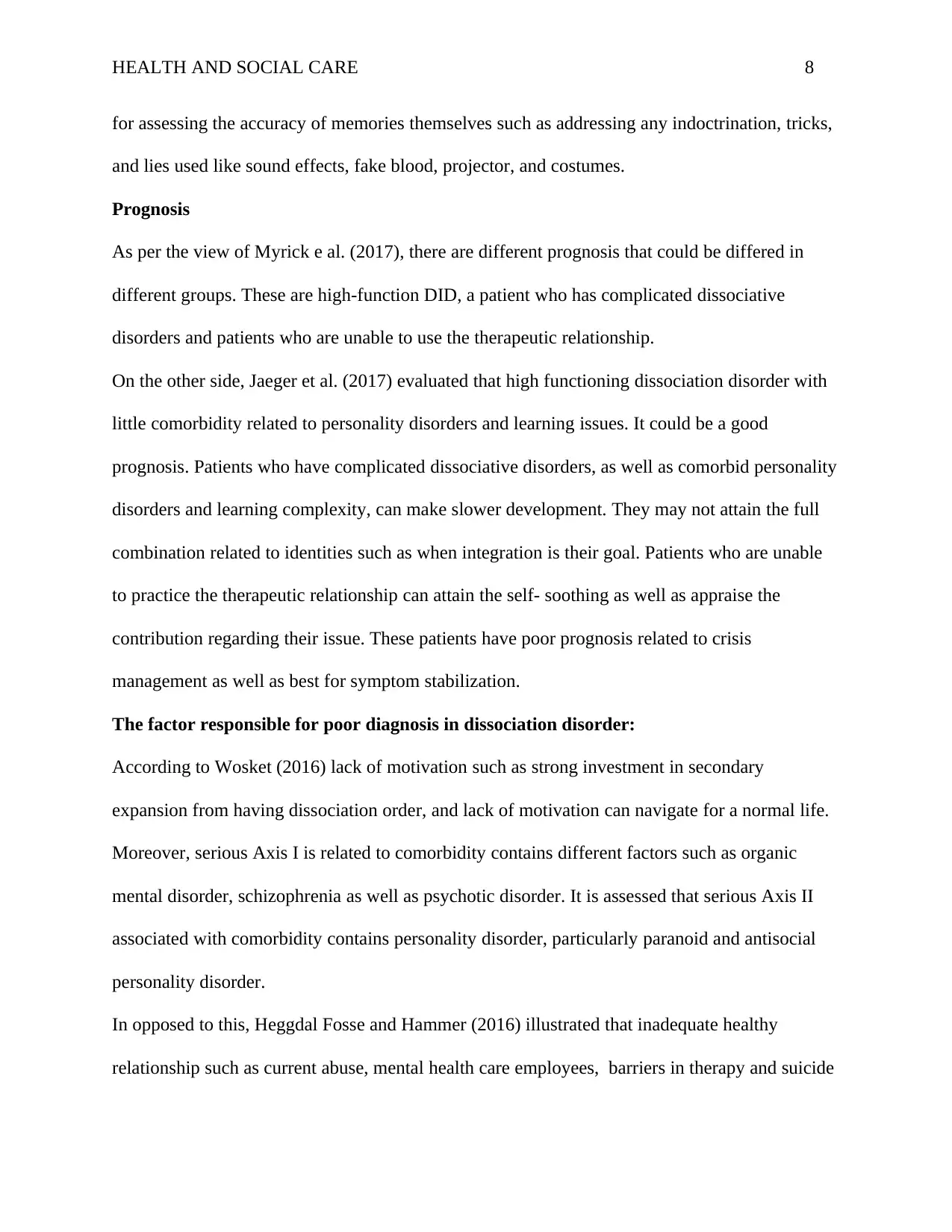
HEALTH AND SOCIAL CARE 8
for assessing the accuracy of memories themselves such as addressing any indoctrination, tricks,
and lies used like sound effects, fake blood, projector, and costumes.
Prognosis
As per the view of Myrick e al. (2017), there are different prognosis that could be differed in
different groups. These are high-function DID, a patient who has complicated dissociative
disorders and patients who are unable to use the therapeutic relationship.
On the other side, Jaeger et al. (2017) evaluated that high functioning dissociation disorder with
little comorbidity related to personality disorders and learning issues. It could be a good
prognosis. Patients who have complicated dissociative disorders, as well as comorbid personality
disorders and learning complexity, can make slower development. They may not attain the full
combination related to identities such as when integration is their goal. Patients who are unable
to practice the therapeutic relationship can attain the self- soothing as well as appraise the
contribution regarding their issue. These patients have poor prognosis related to crisis
management as well as best for symptom stabilization.
The factor responsible for poor diagnosis in dissociation disorder:
According to Wosket (2016) lack of motivation such as strong investment in secondary
expansion from having dissociation order, and lack of motivation can navigate for a normal life.
Moreover, serious Axis I is related to comorbidity contains different factors such as organic
mental disorder, schizophrenia as well as psychotic disorder. It is assessed that serious Axis II
associated with comorbidity contains personality disorder, particularly paranoid and antisocial
personality disorder.
In opposed to this, Heggdal Fosse and Hammer (2016) illustrated that inadequate healthy
relationship such as current abuse, mental health care employees, barriers in therapy and suicide
for assessing the accuracy of memories themselves such as addressing any indoctrination, tricks,
and lies used like sound effects, fake blood, projector, and costumes.
Prognosis
As per the view of Myrick e al. (2017), there are different prognosis that could be differed in
different groups. These are high-function DID, a patient who has complicated dissociative
disorders and patients who are unable to use the therapeutic relationship.
On the other side, Jaeger et al. (2017) evaluated that high functioning dissociation disorder with
little comorbidity related to personality disorders and learning issues. It could be a good
prognosis. Patients who have complicated dissociative disorders, as well as comorbid personality
disorders and learning complexity, can make slower development. They may not attain the full
combination related to identities such as when integration is their goal. Patients who are unable
to practice the therapeutic relationship can attain the self- soothing as well as appraise the
contribution regarding their issue. These patients have poor prognosis related to crisis
management as well as best for symptom stabilization.
The factor responsible for poor diagnosis in dissociation disorder:
According to Wosket (2016) lack of motivation such as strong investment in secondary
expansion from having dissociation order, and lack of motivation can navigate for a normal life.
Moreover, serious Axis I is related to comorbidity contains different factors such as organic
mental disorder, schizophrenia as well as psychotic disorder. It is assessed that serious Axis II
associated with comorbidity contains personality disorder, particularly paranoid and antisocial
personality disorder.
In opposed to this, Heggdal Fosse and Hammer (2016) illustrated that inadequate healthy
relationship such as current abuse, mental health care employees, barriers in therapy and suicide
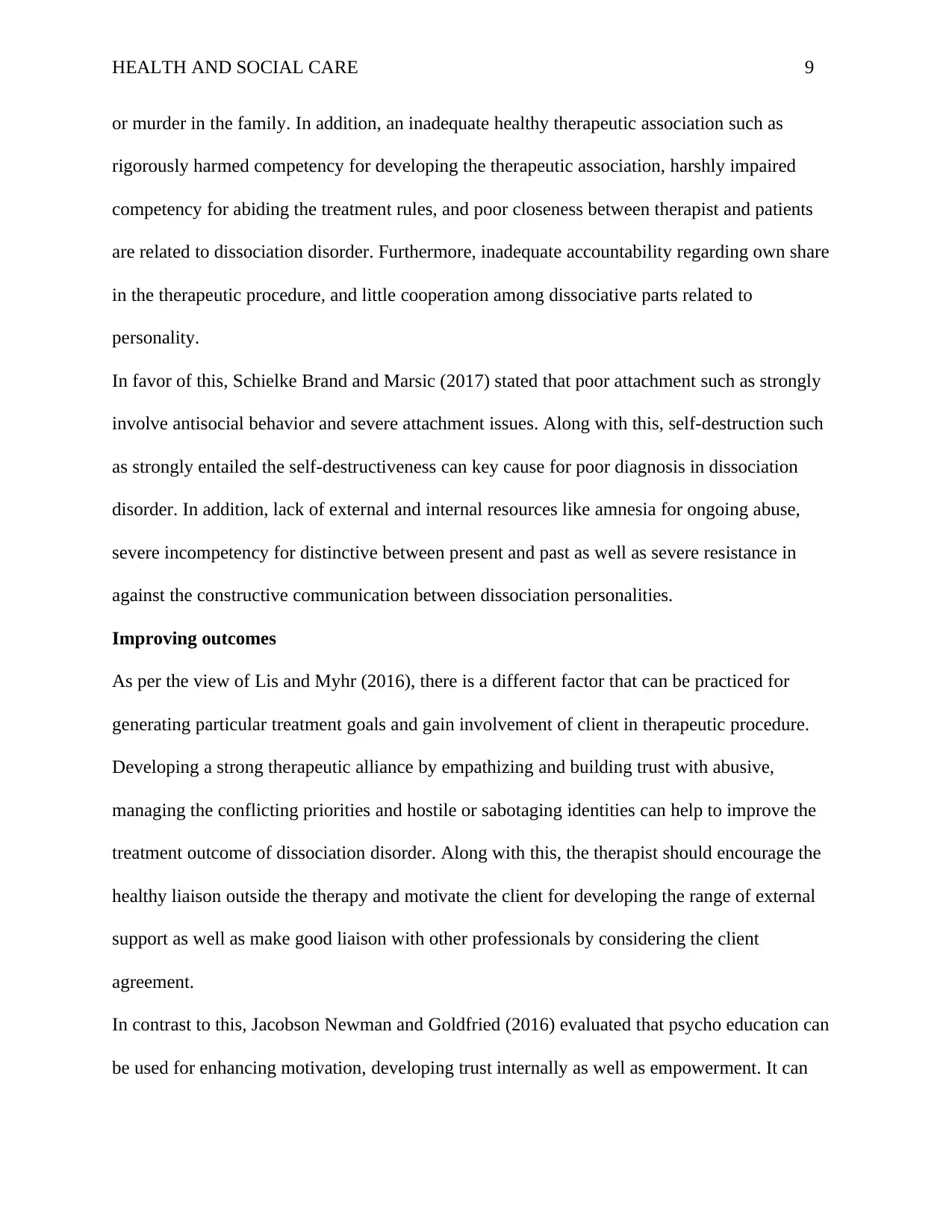
HEALTH AND SOCIAL CARE 9
or murder in the family. In addition, an inadequate healthy therapeutic association such as
rigorously harmed competency for developing the therapeutic association, harshly impaired
competency for abiding the treatment rules, and poor closeness between therapist and patients
are related to dissociation disorder. Furthermore, inadequate accountability regarding own share
in the therapeutic procedure, and little cooperation among dissociative parts related to
personality.
In favor of this, Schielke Brand and Marsic (2017) stated that poor attachment such as strongly
involve antisocial behavior and severe attachment issues. Along with this, self-destruction such
as strongly entailed the self-destructiveness can key cause for poor diagnosis in dissociation
disorder. In addition, lack of external and internal resources like amnesia for ongoing abuse,
severe incompetency for distinctive between present and past as well as severe resistance in
against the constructive communication between dissociation personalities.
Improving outcomes
As per the view of Lis and Myhr (2016), there is a different factor that can be practiced for
generating particular treatment goals and gain involvement of client in therapeutic procedure.
Developing a strong therapeutic alliance by empathizing and building trust with abusive,
managing the conflicting priorities and hostile or sabotaging identities can help to improve the
treatment outcome of dissociation disorder. Along with this, the therapist should encourage the
healthy liaison outside the therapy and motivate the client for developing the range of external
support as well as make good liaison with other professionals by considering the client
agreement.
In contrast to this, Jacobson Newman and Goldfried (2016) evaluated that psycho education can
be used for enhancing motivation, developing trust internally as well as empowerment. It can
or murder in the family. In addition, an inadequate healthy therapeutic association such as
rigorously harmed competency for developing the therapeutic association, harshly impaired
competency for abiding the treatment rules, and poor closeness between therapist and patients
are related to dissociation disorder. Furthermore, inadequate accountability regarding own share
in the therapeutic procedure, and little cooperation among dissociative parts related to
personality.
In favor of this, Schielke Brand and Marsic (2017) stated that poor attachment such as strongly
involve antisocial behavior and severe attachment issues. Along with this, self-destruction such
as strongly entailed the self-destructiveness can key cause for poor diagnosis in dissociation
disorder. In addition, lack of external and internal resources like amnesia for ongoing abuse,
severe incompetency for distinctive between present and past as well as severe resistance in
against the constructive communication between dissociation personalities.
Improving outcomes
As per the view of Lis and Myhr (2016), there is a different factor that can be practiced for
generating particular treatment goals and gain involvement of client in therapeutic procedure.
Developing a strong therapeutic alliance by empathizing and building trust with abusive,
managing the conflicting priorities and hostile or sabotaging identities can help to improve the
treatment outcome of dissociation disorder. Along with this, the therapist should encourage the
healthy liaison outside the therapy and motivate the client for developing the range of external
support as well as make good liaison with other professionals by considering the client
agreement.
In contrast to this, Jacobson Newman and Goldfried (2016) evaluated that psycho education can
be used for enhancing motivation, developing trust internally as well as empowerment. It can
⊘ This is a preview!⊘
Do you want full access?
Subscribe today to unlock all pages.

Trusted by 1+ million students worldwide
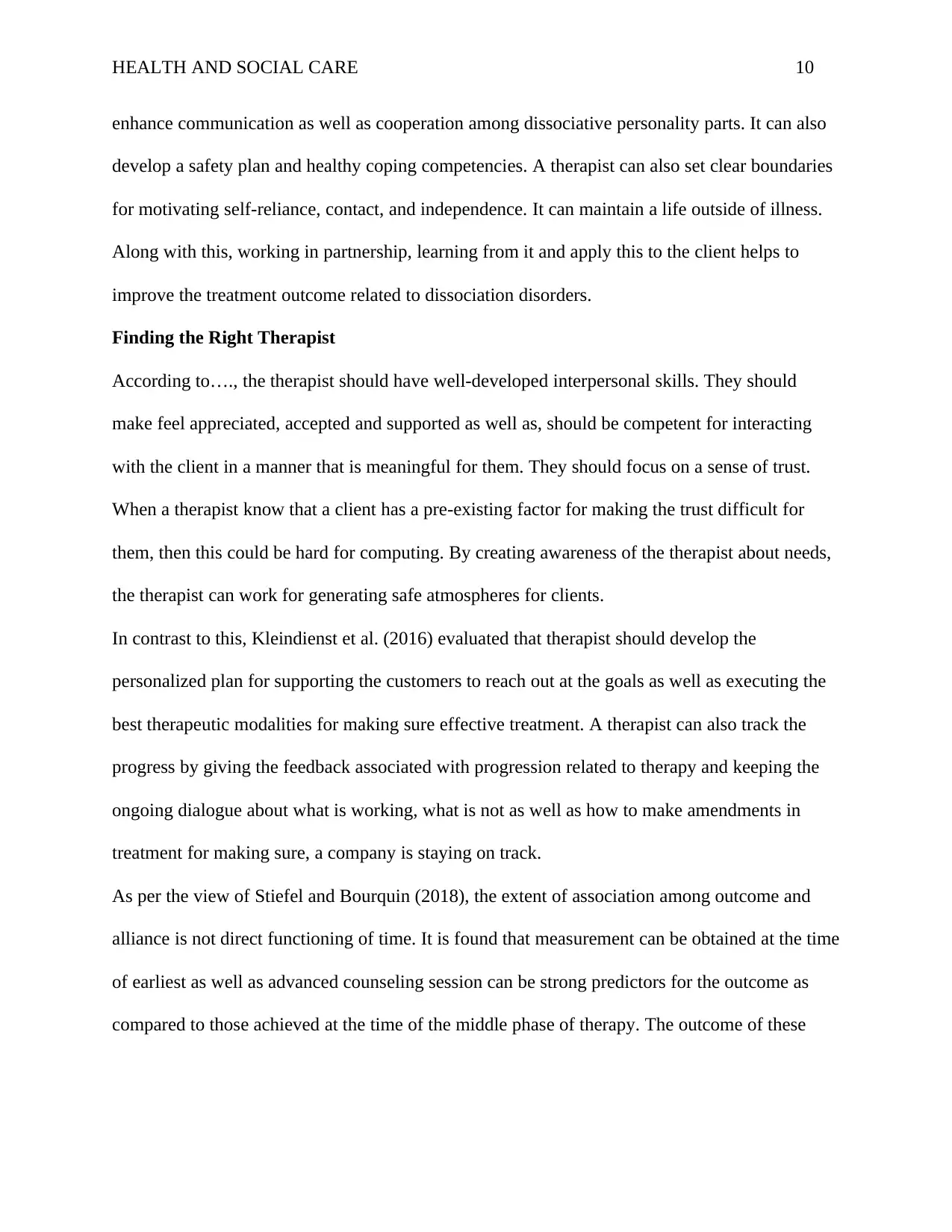
HEALTH AND SOCIAL CARE 10
enhance communication as well as cooperation among dissociative personality parts. It can also
develop a safety plan and healthy coping competencies. A therapist can also set clear boundaries
for motivating self-reliance, contact, and independence. It can maintain a life outside of illness.
Along with this, working in partnership, learning from it and apply this to the client helps to
improve the treatment outcome related to dissociation disorders.
Finding the Right Therapist
According to…., the therapist should have well-developed interpersonal skills. They should
make feel appreciated, accepted and supported as well as, should be competent for interacting
with the client in a manner that is meaningful for them. They should focus on a sense of trust.
When a therapist know that a client has a pre-existing factor for making the trust difficult for
them, then this could be hard for computing. By creating awareness of the therapist about needs,
the therapist can work for generating safe atmospheres for clients.
In contrast to this, Kleindienst et al. (2016) evaluated that therapist should develop the
personalized plan for supporting the customers to reach out at the goals as well as executing the
best therapeutic modalities for making sure effective treatment. A therapist can also track the
progress by giving the feedback associated with progression related to therapy and keeping the
ongoing dialogue about what is working, what is not as well as how to make amendments in
treatment for making sure, a company is staying on track.
As per the view of Stiefel and Bourquin (2018), the extent of association among outcome and
alliance is not direct functioning of time. It is found that measurement can be obtained at the time
of earliest as well as advanced counseling session can be strong predictors for the outcome as
compared to those achieved at the time of the middle phase of therapy. The outcome of these
enhance communication as well as cooperation among dissociative personality parts. It can also
develop a safety plan and healthy coping competencies. A therapist can also set clear boundaries
for motivating self-reliance, contact, and independence. It can maintain a life outside of illness.
Along with this, working in partnership, learning from it and apply this to the client helps to
improve the treatment outcome related to dissociation disorders.
Finding the Right Therapist
According to…., the therapist should have well-developed interpersonal skills. They should
make feel appreciated, accepted and supported as well as, should be competent for interacting
with the client in a manner that is meaningful for them. They should focus on a sense of trust.
When a therapist know that a client has a pre-existing factor for making the trust difficult for
them, then this could be hard for computing. By creating awareness of the therapist about needs,
the therapist can work for generating safe atmospheres for clients.
In contrast to this, Kleindienst et al. (2016) evaluated that therapist should develop the
personalized plan for supporting the customers to reach out at the goals as well as executing the
best therapeutic modalities for making sure effective treatment. A therapist can also track the
progress by giving the feedback associated with progression related to therapy and keeping the
ongoing dialogue about what is working, what is not as well as how to make amendments in
treatment for making sure, a company is staying on track.
As per the view of Stiefel and Bourquin (2018), the extent of association among outcome and
alliance is not direct functioning of time. It is found that measurement can be obtained at the time
of earliest as well as advanced counseling session can be strong predictors for the outcome as
compared to those achieved at the time of the middle phase of therapy. The outcome of these
Paraphrase This Document
Need a fresh take? Get an instant paraphrase of this document with our AI Paraphraser
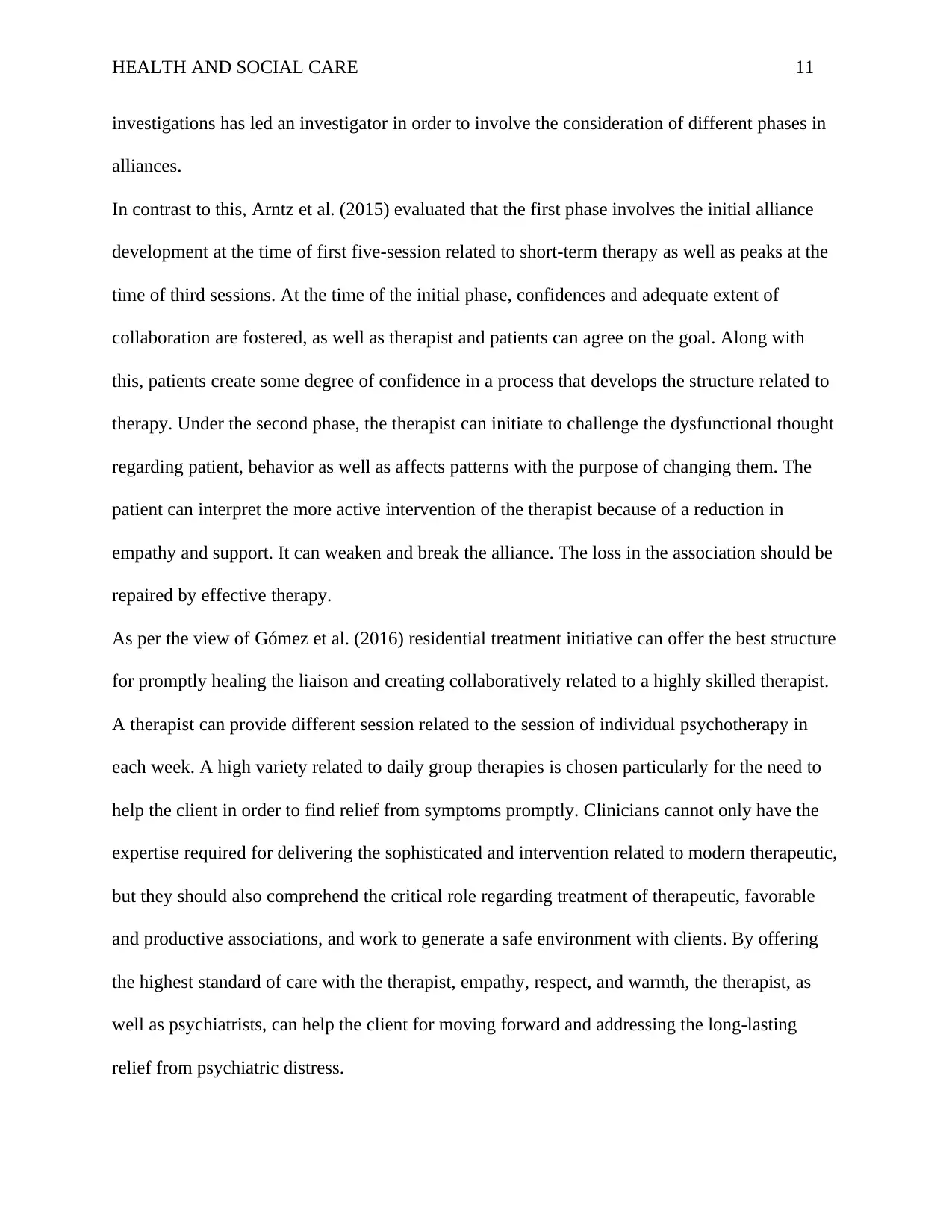
HEALTH AND SOCIAL CARE 11
investigations has led an investigator in order to involve the consideration of different phases in
alliances.
In contrast to this, Arntz et al. (2015) evaluated that the first phase involves the initial alliance
development at the time of first five-session related to short-term therapy as well as peaks at the
time of third sessions. At the time of the initial phase, confidences and adequate extent of
collaboration are fostered, as well as therapist and patients can agree on the goal. Along with
this, patients create some degree of confidence in a process that develops the structure related to
therapy. Under the second phase, the therapist can initiate to challenge the dysfunctional thought
regarding patient, behavior as well as affects patterns with the purpose of changing them. The
patient can interpret the more active intervention of the therapist because of a reduction in
empathy and support. It can weaken and break the alliance. The loss in the association should be
repaired by effective therapy.
As per the view of Gómez et al. (2016) residential treatment initiative can offer the best structure
for promptly healing the liaison and creating collaboratively related to a highly skilled therapist.
A therapist can provide different session related to the session of individual psychotherapy in
each week. A high variety related to daily group therapies is chosen particularly for the need to
help the client in order to find relief from symptoms promptly. Clinicians cannot only have the
expertise required for delivering the sophisticated and intervention related to modern therapeutic,
but they should also comprehend the critical role regarding treatment of therapeutic, favorable
and productive associations, and work to generate a safe environment with clients. By offering
the highest standard of care with the therapist, empathy, respect, and warmth, the therapist, as
well as psychiatrists, can help the client for moving forward and addressing the long-lasting
relief from psychiatric distress.
investigations has led an investigator in order to involve the consideration of different phases in
alliances.
In contrast to this, Arntz et al. (2015) evaluated that the first phase involves the initial alliance
development at the time of first five-session related to short-term therapy as well as peaks at the
time of third sessions. At the time of the initial phase, confidences and adequate extent of
collaboration are fostered, as well as therapist and patients can agree on the goal. Along with
this, patients create some degree of confidence in a process that develops the structure related to
therapy. Under the second phase, the therapist can initiate to challenge the dysfunctional thought
regarding patient, behavior as well as affects patterns with the purpose of changing them. The
patient can interpret the more active intervention of the therapist because of a reduction in
empathy and support. It can weaken and break the alliance. The loss in the association should be
repaired by effective therapy.
As per the view of Gómez et al. (2016) residential treatment initiative can offer the best structure
for promptly healing the liaison and creating collaboratively related to a highly skilled therapist.
A therapist can provide different session related to the session of individual psychotherapy in
each week. A high variety related to daily group therapies is chosen particularly for the need to
help the client in order to find relief from symptoms promptly. Clinicians cannot only have the
expertise required for delivering the sophisticated and intervention related to modern therapeutic,
but they should also comprehend the critical role regarding treatment of therapeutic, favorable
and productive associations, and work to generate a safe environment with clients. By offering
the highest standard of care with the therapist, empathy, respect, and warmth, the therapist, as
well as psychiatrists, can help the client for moving forward and addressing the long-lasting
relief from psychiatric distress.
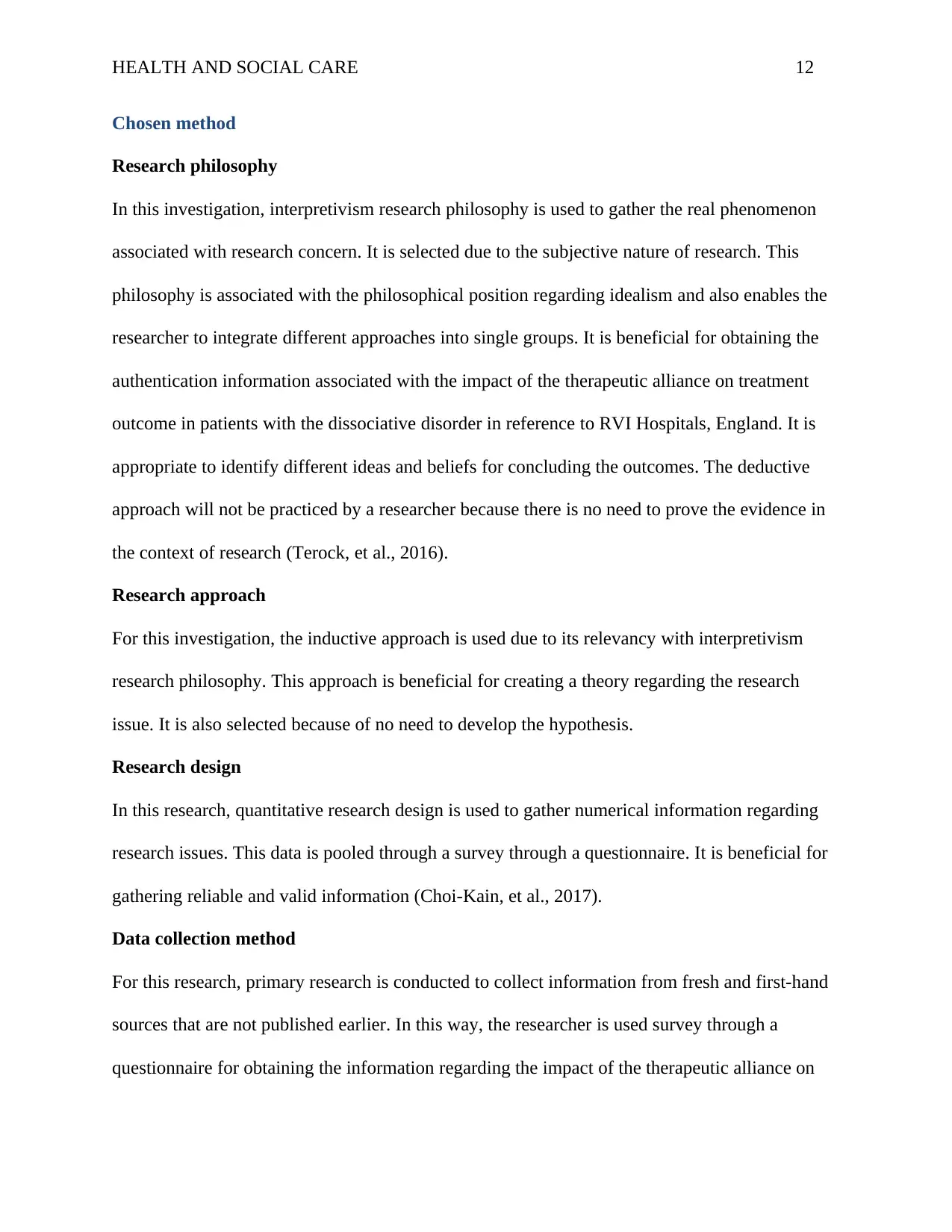
HEALTH AND SOCIAL CARE 12
Chosen method
Research philosophy
In this investigation, interpretivism research philosophy is used to gather the real phenomenon
associated with research concern. It is selected due to the subjective nature of research. This
philosophy is associated with the philosophical position regarding idealism and also enables the
researcher to integrate different approaches into single groups. It is beneficial for obtaining the
authentication information associated with the impact of the therapeutic alliance on treatment
outcome in patients with the dissociative disorder in reference to RVI Hospitals, England. It is
appropriate to identify different ideas and beliefs for concluding the outcomes. The deductive
approach will not be practiced by a researcher because there is no need to prove the evidence in
the context of research (Terock, et al., 2016).
Research approach
For this investigation, the inductive approach is used due to its relevancy with interpretivism
research philosophy. This approach is beneficial for creating a theory regarding the research
issue. It is also selected because of no need to develop the hypothesis.
Research design
In this research, quantitative research design is used to gather numerical information regarding
research issues. This data is pooled through a survey through a questionnaire. It is beneficial for
gathering reliable and valid information (Choi-Kain, et al., 2017).
Data collection method
For this research, primary research is conducted to collect information from fresh and first-hand
sources that are not published earlier. In this way, the researcher is used survey through a
questionnaire for obtaining the information regarding the impact of the therapeutic alliance on
Chosen method
Research philosophy
In this investigation, interpretivism research philosophy is used to gather the real phenomenon
associated with research concern. It is selected due to the subjective nature of research. This
philosophy is associated with the philosophical position regarding idealism and also enables the
researcher to integrate different approaches into single groups. It is beneficial for obtaining the
authentication information associated with the impact of the therapeutic alliance on treatment
outcome in patients with the dissociative disorder in reference to RVI Hospitals, England. It is
appropriate to identify different ideas and beliefs for concluding the outcomes. The deductive
approach will not be practiced by a researcher because there is no need to prove the evidence in
the context of research (Terock, et al., 2016).
Research approach
For this investigation, the inductive approach is used due to its relevancy with interpretivism
research philosophy. This approach is beneficial for creating a theory regarding the research
issue. It is also selected because of no need to develop the hypothesis.
Research design
In this research, quantitative research design is used to gather numerical information regarding
research issues. This data is pooled through a survey through a questionnaire. It is beneficial for
gathering reliable and valid information (Choi-Kain, et al., 2017).
Data collection method
For this research, primary research is conducted to collect information from fresh and first-hand
sources that are not published earlier. In this way, the researcher is used survey through a
questionnaire for obtaining the information regarding the impact of the therapeutic alliance on
⊘ This is a preview!⊘
Do you want full access?
Subscribe today to unlock all pages.

Trusted by 1+ million students worldwide
1 out of 33
Related Documents
Your All-in-One AI-Powered Toolkit for Academic Success.
+13062052269
info@desklib.com
Available 24*7 on WhatsApp / Email
![[object Object]](/_next/static/media/star-bottom.7253800d.svg)
Unlock your academic potential
Copyright © 2020–2025 A2Z Services. All Rights Reserved. Developed and managed by ZUCOL.




